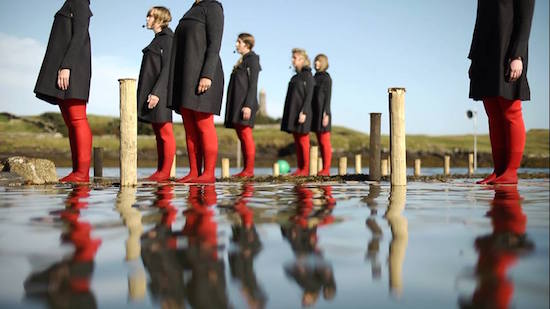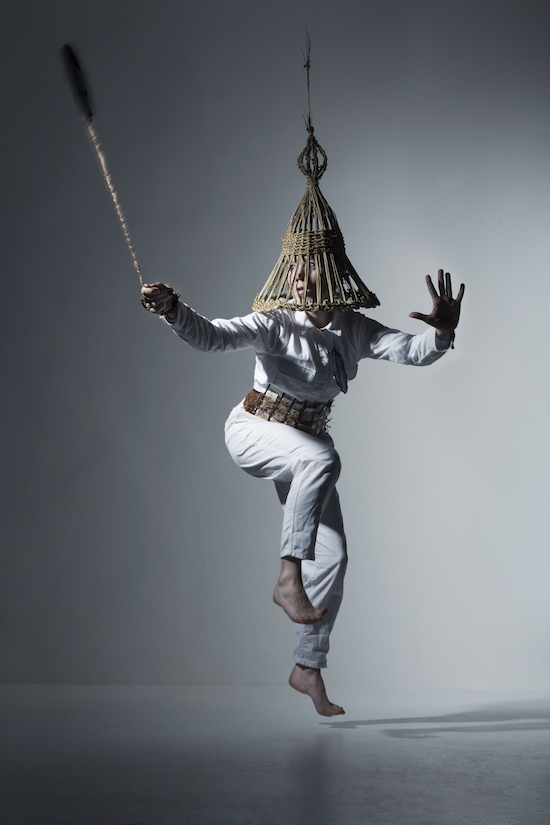Women of the Hill performance. Images credit: Simon Groom
At dusk on Halloween last year, Hanna Tuulikki took to the hills of Skye to perform Women of the Hill, the Edinburgh-based artist’s latest exploration of what she calls ‘mnemonic topography’. Her art maps and animates the cultural inscriptions of a landscape: ‘the land encoded in the song, the lore embedded in the land’, as she puts it.
By the entrance to High Pasture Cave, an Iron Age burial site, Tuulikki and fellow performers Lucy Duncombe and Nerea Bello used voice, gesture and costume to enact a battle between Celtic goddesses and lament the death of an ancient priestess. At the end, they bring in the new year with a toast to the women of the hill: the goddesses, the matriarch ancestors, and mothers. Comissioned by Skye’s pioneering ATLAS Arts, Women of the Hill, was a genuinely magical experience, bringing the history and legends of the site to life.
Having been so entranced by this performance, I was keen to find out more about Tuulikki’s practice. Music fans may be familiar with her avant-folk group Nalle, who released three fine albums between 2006 and 2010, and her contributions to albums by Scatter and RM Hubbert.
She currently plays in the folk-pop band Two Wings, alongside Duncombe and guitarist Ben Reynolds. Music, and the voice in particular, is central to Tuulikki’s work, from early projects imitating the sounds of waves and seals, through to her largest work to date, the multi-media Away With The Birds.
As a graduate of Glasgow School of Art’s celebrated Environmental Art course, Tuulikki is perhaps understandably influenced by Joseph Beuys’s ecologically oriented social sculpture, but other key reference points are Meredith Monk and Pauline Oliveros.

Away with the Birds. Photo credit: Alex Boyd
Can you take us back to the origins of your practice?
HT: While I was at art school I was making work where I was interested in either a dialogue with myself and what I now call the more-than-human world after David Abram, or losing my sense of humanness, like I wanted to define myself through similarities with species that aren’t human. I did a residency in Cromarty and did a piece called Airs of the Sea: 100 Breaths, 100 Waves (2006). It was in response to Pauline Oliveros’s Deep Listening. I was sitting on the shore in Cromarty and listening to the waves and listening to my own breaths and feeling how similar the rhythms were.
I went from door to door to a hundred different houses and asked people to breathe for me and then I made a sound installation, like a collage from all these breaths that emulated the sea. There was also a hammock, so you, as in the person in the exhibition, would float on the sea. So I was also interested in creating a space of active engagement with sound work.
Then I did a project in Liverpool, [Kensington Cradle Songs, 2007] which was looking at lullabies from around the world, working with people from different communities, looking at the shared qualities of lullabies, like the soft sibilant sounds and the lilting rhythms and minor thirds, and that was an installation with rocking chairs and fire and sound.
So there’s a shared interest in folklore and place, which relates to your concept of mnemonic topography.
HT: I’d been really interested in traditional music from around the world where people have an intimate connection with the land, like in the nomadic people of Tuva and Sakha, where people throat sing the mountains and are really good imitators of animals. Their music is growing directly from their relationship with the land. It’s like a musical eco-system.
I was becoming more and more convinced that music and language developed from what could be called mimesis. There’s a really interesting book that ethnomusicologist Ted Levin wrote called Where Rivers And Mountains Sing and he very beautifully defines different kinds of mimesis within the Tuvan and Sakhan musical worlds, but I wanted to look for this kind of sound making practice closer to home. I found two songs in the English speaking song tradition, but they probably both have their origins in Ireland, ‘The Cuckoo’ and ‘The Blackbird’. Then I met [the great Gaelic singer] Christine Primose on Skye and she told me about these songs [in the Gaelic tradition] that imitate birds. I’d been looking for something like this for a long time.

Away with the Birds. Image credit: Daniel Warren
And so, over four years, Away With The Birds took shape, beginning as a composition for a single voice, then a trio, and then a nonet for the 2013 Tectonics Festival in Glasgow. The fullest realisation of the piece came in 2014, when Tuulikki, accompanied by nine other vocalists and a sound engineer, travelled to the Hebridean island of Canna to perform it on the beach. As Tuulikki explains, the composition is based on fragments of songs and poems, which are arranged into movements which correspond with certain species and places
HT: The first movement is by the shoreline. The second movement is on the cliffs, so that’s kind of the more social, chattery movement, it’s like the colonies of the birds and the territories and courting rituals, and there’s a song from St Kilda in there, so I always imagine it there. And then the third movement is an ebb-tide lament. The fourth movement, the first half is the flocking of gulls, and I was thinking like vocal flocking, so it’s not just the sounds that we were evoking, but a sense of the movement of the birds. So for example, in the later half of movement, after a cuckoo call, there are some whooper swan recordings by Geoff Sample and it turns into an evocation of whooper swans from a very slow hocket. It’s choreographed in a way that the performers are always in a V shape with a rotating leader, so a bit like the way birds support the leader and then change.
I began researching the songs in depth, the context, the cultural meanings, and was really interested to notice a lot of these songs were being sung from a woman’s perspective or about women, everyday women or mythic women, so there was a really strong female identity which gave a double meaning to Away With The Birds.
Another aspect of Away With The Birds is its beautiful visual score, hand drawn by Tuulikki herself. She sees the score as a dramaturgical and conceptual tool, which helped her understand the narrative within in the work, and shape the performance. To develop the performative aspects of the piece, Tuulikki worked with choreographer Rosalind Masson and performance artist Nic Green. Deirdre Nelson also came on board as costume designer, pairing black and white dresses with red tights so that the singers resembled oystercatchers
HT: Being quite heavily influenced by Meredith Monk, obviously, I’m really interested in the idea of choreographing for the voice, but also in the sense that the body and the voice move together and breath being the preliminary starting point for that. We did a performance in [Glasgow] Tramway, kind of an early working sketch of the bigger version of Away With The Birds, but I think it pushed too far and the movements were sometimes detracting from the actual vocal directness. So when we did the performance on Canna the movement was really minimal and it was actually more about being in the place and our positions within the landscape.
I really like your poetic description of mnemonic topography, ‘the land encoded in the song, the lore embedded in the land.’ It’s as if you’re animating the cultural inscriptions on the landscape, conversing with them.
HT: Absolutely. Through Away With The Birds I became really aware of the relationship of particular sound making practices, or particular songs or poems with specific landscapes and, yeah, I was interested in making work that actively engaged with that, animating as you say, but also this relationship between science and sentiment, so I got really obsessed with archeo-acoustics and how particular landscapes might hold significance because of the acoustic qualities of that landscape. So I like singing at hills, it’s like a bit of a thing, and yeah, that’s how Women of the Hill evolved.

Women of the Hill. Photo credit: Lawrence Winram
You first visited High Pasture Cave in May 2013. It clearly left an impression on you.
HT: I’d met [poet] Meg Bateman the evening before and she said ‘Watch out for the dreams.’ The cave, it’s like a birth canal. The acoustics are pretty dry, quite surprisingly, but there’s this constant rushing sound of water, because it’s a water worn limestone cave, and I spent quite a lot of time in there. And when I emerged back into the daylight it was incredibly striking, this sensory experience, the deprivation of light and the cold humidity of the cave, and then emerging to this bright heat. That night I had this really amazing dream where I was flying up, up, up, up through a library which was really old and had lots of dusty books. And then the library opened up and it turned into a forest and I was flying up and up and up. And I realised just after rehearsals began for Women of the Hill I was revisiting my process and my journey for the cave and I realised it was like an invitation to bring to life this living library of tradition that had been buried beneath the green. So that dream feels really connected to this mnemonic topographies process. But I feel like all my work actively deals with that relationship between sound and place.
Turning to the ecopoetics of the piece, do you see your play on the place names and the figure of Bridget/Bride as another way of animating the lore embedded in the land?
HT: Yeah, for sure. There are so many histories – her-stories – embedded within the landscape of High Pasture Cave. The layering through time, the strata and the mythology is inextricably tied to the naming of the place. So [the nearby settlement] Kilbride is Church of Bride, but before Bride was a Christian saint, she was a [Celtic] goddess. Almost opposite [the hill] is [the mountain] Beinn na Caillich, and Cailleach in Celtic folklore is the hag goddess, creatrix, shaper of the land, and there’s a whole mythology about the goddesses having a battle twice yearly. Then the actual cave itself, archaeologists discovered that on the first of February, Bride’s Day or Imbolc [a Celtic fire festival], the sun shone directly into the cave."
Then of course you’ve got the layering of the Iron Age. The archaeologists called this mysterious woman who was buried at the threshold of the cave Bridget, after the goddess, because they believed that this cave was dedicated to this goddess. One of the theories is that this woman was a priestess serving the local township who worshipped the goddess Bride and this cave was like a cathedral to Bride and the area above the cave was a ritual space. We know that there was music taking place there, because they found the bridge of a lyre in the ashes of a fire, so it was interesting to reactivate sound there. So the first act, yes, it is this battle between the goddesses and it’s playing with the natural acoustics, this extreme echo from the hill, and the second movement is exploring forms of laments and reimagining what ritual lament might have been in the context of this woman’s death and then bringing it into the modern age with real words in English.
Tuulikki is currently working on a number of projects, including a short film about Sweeney, the mad king of Irish legend who turned into a bird. To find out more about all her projects visit her website.


